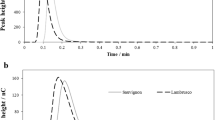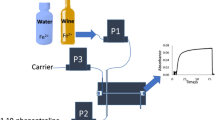Abstract
The objective of the present work was to adapt the 1,1-diphenyl-2-picrylhydrazyl (DPPH) assay to a system of flow injection analysis (FIA) of merging zones to determine the antioxidant capacity of wine samples. The conditions of the FIA system proposed here were optimized with the response surface methodology using central composite rotatable design. The optimization parameters studied here were the carrier flow rate, the length of the sampling and reagent loops, and the length of the reaction coil. The experimental data were fitted to a polynomial model, and the optimal conditions were: flow rate of 1.12 mL min−1, loop length of 18.5 cm, and reaction coil length of 234.60 cm. The limits of detection and quantification were 2.65 and 8.82 μM of Trolox, respectively. The method proposed had an analytical frequency of 41 analyses per hour and a reagent consumption economy of 57.3 % for DPPH in relation to the conventional method. The results of the antioxidant activities of the wine samples obtained with the proposed method were correlated and compared to those of the conventional method.




Similar content being viewed by others
References
Arnous A, Makris DP, Kefalas P (2002) Correlation of pigment and flavanol content with antioxidant properties in selected aged regional wines from Greece. J Food Comp Anal 15:655–665
Auta M, Hameed BH (2011) Optimized waste tea activated carbon for adsorption of Methylene Blue and Acid Blue 29 dyes using response surface methodology. Chem Eng J 175:233–243
Bezerra AM, Santelli RE, Oliveira EP, Villar LS, Escaleira LA (2008) Response surface methodology (RSM) as a tool for optimization in analytical chemistry. Talanta 76:965–977
Beer D, Joubert E, Gelderblom WCA, Manley M (2002) Phenolic compounds: a review of their possible role as in vivo antioxidants of wine. S Afri Enol Vitic 23:48–61
Bergamin H, Zagatto EAG, Krug FJ, Reis BF (1978) Merging zones in flow injection analysis: part 1. Double proportional injector and reagent consumption. Anal Chim Acta 101:17–23
Bursal E, Gülcin I (2011) Polyphenol contents and in vitro antioxidant activities of lyophilised aqueous extract of kiwifruit (Actinidia deliciosa). Food Res Int 44:1482–1489
Cerqueira FM, Medeiros MHG, Augusto O (2007) Dietetic antioxidants: controversies and perspectives. Quim Nova 30:441–449
Dawidowicz AL, Wianowska D, Olszowy M (2012) On practical problems in estimation of antioxidant activity of compounds by DPPH method (problems in estimation of antioxidant activity). Food Chem 131:1037–1043
Flamini R (2003) Mass spectrometry in grape and wine chemistry. Part I: Polyphenols. Mass Spectrom Rev 22:218–250
Fonseca SGC, Silva LBL, Castro RF, Santana PP (2004) Validação da metodologia analítica para doseamento de soluções de lapachol por CLAE. Quim Nova 27:157–159
Lo Presti RMD, Carollo CMD, Caimi GMD (2007) Wine consumption and renal diseases: new perspectives. Nutrition 23:598–602
Gan C, Latiff AA (2011) Optimization of the solvent extraction of bioactive compounds from Parkia speciosa pod using response surface methodology. Food Chem 124:1277–1283
Granato D, Katayama FCU, Castro IA (2010) Assessing the association between phenolic compounds and the antioxidant activity of Brazilian red wines using chemometrics. LWT-Food Sci Technol 43:1542–1549
Habibi H, Mohammadi A, Hoseini H, Mohammadi M, Azadniya E (2012) Headspace liquid-phase microextraction followed by gas chromatography–mass spectrometry for determination of furanic compounds in baby foods and method optimization using response surface methodology. Food Anal Methods. doi:10.1007/s12161-012-9510-7
Halliwell B, Gutteridge JMC (2007) Free radicals in biology and medicine. Oxford University, New York
Hernández-Borges J, Gonzáles-Hernández G, Borges-Miquel T, Rodrigues-Delgado MA (2005) Determination of antioxidants in edible grain derivatives from the Canary Islands by capillary electrophoresis. Food Chem 91:105–111
Jacintho AO, Zagatto EAG, Reis BF, Pessenda LCR, Krug FJ (1981) Merging zones in flow injection analysis: Part 6. Determination of calcium in natural waters, soil and plant materials with glyoxal bis(2-hydroxyanil). Anal Chim Acta 130:361–368
Martins AC, Bukman L, Vargas AMM, Barizão EO, Moraes JCG, Visentainer JV, Almeida VC (2013) The antioxidant activity of teas measured by the FRAP method adapted to the FIA system: optimising the conditions using the response surface methodology. Food Chem 138:574–580
Magalhães LM, Santos M, Segundo MA, Reis S, Lima JLFC (2006) Automatic method for determination of total antioxidant capacity using 2,2-diphenyl-1-picrylhydrazyl assay. Anal Chim Acta 558:310–318
Magalhães LM, Santos M, Segundo MA, Reis S, Lima JLFC (2008) Flow injection methods for fast screening of antioxidant capacity. Talanta 77:1559–1566
Medeiros RA, Rocha-Filho RC, Fatibello-Filho O (2010) Simultaneous voltammetric determination of phenolic antioxidants in food using a boron-doped diamond electrode. Food Chem 123:886–891
Minussi RC, Rossi M, Bologna L, Cordi L, Rotilio D, Pastore GM (2003) Phenolic compounds and total antioxidant potential of commercial wines. Food Chem 82:409–416
Mrazek N, Watla-iad K, Deachathai S, Suteerapataranon S (2012) Rapid antioxidant capacity screening in herbal extracts using a simple flow injection-spectrophotometric system. Food Chem 132:544–548
Myers RH, Montgomery DC (2002) Response surface methodology: process end product optimization using designed experiments. Wiley, New York
Naissaides M, Mamo JCL, James AP, Pal S (2006) The effect of chronic consumption of red wine on cardiovascular disease risk factors in postmenopausal women. Atherosclerosis 185:438–445
Nixdorf SL, Gutiérrez IH (2010) Brazilian red wines made from the hybrid grape cultivar Isabel: Phenolic composition and antioxidant capacity. Anal Chim Acta 659:208–215
Ozsoy N, Can A, Yanardag R, Akev N (2008) Antioxidant actvity of Smilax excelsa L. leaf extracts. Food Chem 110:571–583
Porgali E, Büyüktuncel E (2012) Determination of phenolic composition and antioxidant capacity of native red wines by high performance liquid chromatography and spectrophotometric methods. Food Res Int 45:145–154
Prasad KN, Hassan FA, Yang B, Kong KW, Ramanan RN, Azlan A, Ismail A (2011) Response surface optimization for the extraction of phenolic compounds and antioxidants capacities of underutilised Mangifera pajang Kosterm peels. Food Chem 128:1121–1127
Reis BF, Zagatto EAG, Javcintho AO, Krug FJ, Bergamin HF (1980) Merging zones in flow injection analysis: Part 4. Simultaneous spectrophotometric determination of total nitrogen and phosphorus in plant material. Anal Chim Acta 119:305–311
Roussis I, Lambropoulos I, Tzimas P, Anna G, Marinos V, Tsoupeis D, Boutaris I (2008) Antioxidant activities of some Greek wines and wine phenolic extracts. J Food Comp Anal 21:614–621
Ruzicka J, Hansen EH (1981) Flow injection analysis. Wiley, New York
Shpigun LK, Arharova MA, Brainina KZ, Ivanova AV (2006) Flow injection potentiometric determination of total antioxidant activity of plant extracts. Anal Chim Acta 573:419–426
Thongchai W, Liawruangrath B, Liawruangrath S (2009) Flow injection analysis of total curcuminoids in turmeric and total antioxidant capacity using 2,2-diphenyl-1-picrylhydrazyl assay. Food Chem 112:494–499
Ukeda H, Adachi Y, Sawamura M (2002) Flow injection analysis of DPPH radical based on electron spin resonance. Talanta 58:1279–1283
Vargas AMM, Garcia CA, Reis EM, Lenzi E, Costa WF, Almeida VC (2010) NaOH-activated carbon from flamboyan (Delonix regia) pods: Optimization of preparation conditions using central composite rotatable design. Chem Eng J 162:43–50
Zagatto EAG, Oliveira CO, Townshend A, Worsfold PJ (2012) Flow analysis with spectrophotometric and luminometric detection. Elsevier, Massachusetts, 1st Edition
Zagatto EAG, Jacintho AO, Pessenda LCR, Krug FJ, Reis BF, Bergamin FH (1981) Merging zones in flow injection analysis: Part 5. Simultaneous determination of aluminium and iron in plant digests by a zone-sampling approach. Anal Chim Acta 1981:37–43
Acknowledgments
The authors acknowledge CAPES for the financial support.
Author information
Authors and Affiliations
Corresponding author
Rights and permissions
About this article
Cite this article
Bukman, L., Martins, A.C., Barizão, É.O. et al. DPPH Assay Adapted to the FIA System for the Determination of the Antioxidant Capacity of Wines: Optimization of the Conditions Using the Response Surface Methodology. Food Anal. Methods 6, 1424–1432 (2013). https://doi.org/10.1007/s12161-012-9560-x
Received:
Accepted:
Published:
Issue Date:
DOI: https://doi.org/10.1007/s12161-012-9560-x




